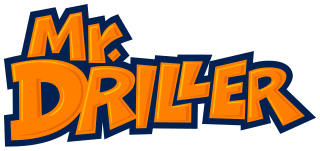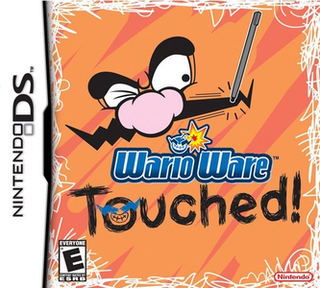
Dr. Mario is a 1990 puzzle video game developed and published by Nintendo for the Nintendo Entertainment System, Famicom, and Game Boy. It was produced by Gunpei Yokoi and designed by Takahiro Harada. The soundtrack was composed by Hirokazu Tanaka.

Mr. Driller is a puzzle video game franchise created by Yasuhito Nagaoka and Hideo Yoshizawa for Namco. The eponymous first game was released in 1999 for arcades and several home consoles, such as the PlayStation. Gameplay in the series consists of controlling Susumu Hori, the titular Mr. Driller, or one of his friends and destroying colorful formations of blocks to make it to the bottom of a well. In order to survive, players need to collect air capsules to replenish their depleting oxygen and avoid being crushed by falling blocks.

WarioWare: Touched! is a minigame compilation party video game released by Nintendo for the Nintendo DS. The fourth installment of the WarioWare series, and the first of three on the Nintendo DS, the game involves rapidly completing "microgames" — simple minigames lasting extremely short periods of time — as quickly as possible. The microgames are exclusively controlled with the Nintendo DS's touchscreen and microphone.

ABA Games is a Japanese video game developer, composed solely of game designer Kenta Cho. ABA Games' works, available as open source, are predominantly shoot 'em up games often inspired by classic games in the genre. Its games feature stylised retro graphics, innovative gameplay features and modes and feature random rather than scripted events. These creations have been acclaimed as some of the best independent games available, though some commentators, including Cho himself, feel they are too simple for commercial release.

Metal Slug 2 is a run and gun video game developed by SNK. It was originally released in 1998 for the Neo-Geo MVS arcade platform as the sequel to the 1996 game Metal Slug. The original version of the game had extensive slowdown and performance issues, eventually leading SNK to release a modified version in 1999 titled Metal Slug X: Super Vehicle-001 (メタルスラッグX). It has been ported to the Neo Geo CD, PlayStation, Virtual Console, iOS and Android, and to the Wii, PlayStation Portable and PlayStation 2. The game added several new features to the gameplay of the original Metal Slug, such as new weapons, vehicles and the ability to transform the character. It received generally positive reviews. It was followed by Metal Slug 3 released in 2000.

Gunhed, known as Blazing Lazers in North America, is a vertically scrolling shooter game by Hudson Soft and Compile, based on the Japanese film Gunhed. The title was released in 1989, for the PC Engine in Japan and re-skinned for the TurboGrafx-16 in North America, with Gunhed unofficially imported for the PC Engine in Europe. In the game, a fictional galaxy is under attack by an enemy space armada called the Dark Squadron, and this galaxy's only chance for survival is the Gunhed Advanced Star Fighter, who must destroy the Dark Squadron and its Super Weapons. The gameplay features fast vertical scrolling and a wide array of weapons for the player to use.
Star Soldier is a series of shoot 'em up video games mainly developed by Hudson Soft. Konami has owned the rights to the series since their absorption of Hudson Soft in 2012. The first game, named Star Soldier, appeared on the MSX and NES in 1986, and the series has continued on various gaming systems. Star Soldier itself has received enhanced remakes for both the GameCube and PlayStation 2 in 2003, and a different remake for the PlayStation Portable in 2005, while the latest installment of the series was released on the Wii as a WiiWare game in 2008. In addition, Super Star Soldier, Final Soldier, Soldier Blade and Star Parodier have been re-released on the Wii's Virtual Console and on the Japanese PC Engine's Best Collection lineup for the PSP. The Star Soldier games are best known for their distinctive music, unique weapon power-ups, and a special time attack high score mode called "Caravan Mode".

Soldier Blade is a 1992 vertical-scrolling shooter video game developed and published by Hudson Soft for the TurboGrafx-16. Controlling the titular starship, the player is tasked with completing each of the game's seven stages in order to wipe out the Zeograd Army, an alien race bent on conquering Earth. The game is the fourth entry in the Star Soldier series and shares many similarities with its predecessor Super Star Soldier, with Soldier Blade having a heavy emphasis on speed.

Cake Mania is a cooking time management video game developed and published by Sandlot Games in 2006. Some ports of Cake Mania have different titles; the Wii version is known as Cake Mania: In the Mix!, and the PlayStation 2 and PlayStation Portable versions are titled Cake Mania: Bakers Challenge. Cake Mania received mixed reviews from critics, with some reviewers praising the game's 'addictive' and 'simple' casual gameplay, while others criticized this as being 'repetitive' and 'shallow'.

Dr. Mario Online Rx, stylized as Dr. Mario Online ℞ and released in PAL regions as Dr. Mario & Germ Buster, is a puzzle video game starring Dr. Mario. It was one of the WiiWare launch games in Japan, Europe, and Australia, and was released in 2008 on March 25 for Japan, on May 20 for Europe and Australia, and for North America on May 26.

Gyrostarr is a shoot 'em up video game developed and published by High Voltage Software. It is one of several video games released only as WiiWare through the Wii Shop Channel, because of this, the game is no longer purchasable due to the shutdown of the Wii Shop Channel. It was released in North America on June 23, 2008.

Protöthea is a shoot 'em up video game developed by Argentinian studio Digital Builders originally released for Windows PCs in 2005. A redesigned version for WiiWare was released in North America on June 2, 2008 and in Europe on October 23, 2009.

Pirates: The Key of Dreams is a shoot 'em up video game by developers Oxygen Games for WiiWare. A prequel to Oxygen's Nintendo DS game Pirates: Duels on the High Seas, it was released in Europe on July 18, 2008 and in North America on July 21, 2008. It costs 1000 Wii Points and takes up 125 Blocks.

Space Invaders Get Even is a video game by Taito for the Wii. Originally intended as a retail release, the game was released as a downloadable WiiWare game instead. It was released in Japan on August 26, 2008, in Europe on November 7, 2008, and in North America on December 1, 2008. Outside Japan the game is published by Square Enix.

Galaga Legions is a 2008 twin-stick shooter video game developed and released by Namco Bandai Games for the Xbox 360. It is the twelfth game in the Galaxian series, and the third developed for home platforms. The player controls a starship, the AEf-7 "Blowneedle", in its efforts to wipe out the Galaga armada. The objective of the game is to clear each of the five stages as quick as possible. Stages have a heavy emphasis on puzzle solving and chain reactions, which are necessary to clear out enemy formations. The Blowneedle has a pair of satellites at its disposal, and can place them anywhere on the screen to fend off enemies.
MaBoShi: The Three Shape Arcade is a WiiWare puzzle video game developed by Mindware Corp. Its Japanese title, Katachi no Game: Maru Bou Shikaku. It was released in Europe on August 29, 2008, in Japan on October 7, 2008, and in North America on December 29, 2008.

Cubello, known in Japan as Cubeleo, was released in North America for WiiWare on October 13, 2008. While it was the third series release, Cubello was the first fully original Art Style series entry, having no bit Generations series counterpart.

Rotohex is a Nintendo video game for the Wii's WiiWare service. It is a remake of the Japan-only bit Generations title Dialhex. It was released as WiiWare in North America on October 27, 2008.

Bit.Trip Beat, marketed as BIT.TRIP BEAT, is an arcade-style music video game developed by Gaijin Games and published by Aksys Games for the Wii's WiiWare download service. It was released in 2009 in North America, and released in Japan and PAL regions in the same year. It was later released for the Windows and Mac OS X through the download service Steam in 2010, while Namco Bandai published it for iOS on iPod Touch, iPhone, and iPad in both Bit.Trip Beat and Bit.Trip Beat HD versions. Android and Linux versions debuted in the Humble Android Bundle 3.

Mr. Driller W is a 2009 puzzle video game developed and published for the WiiWare service by Namco Bandai Games. The eighth entry in the Mr. Driller series, gameplay revolves around clearing each level by destroying, or "drilling", large formations of colorful blocks. Players have an oxygen meter that acts as a time limit, and constantly depletes; air is replenished by collecting air capsules, and is depleted further by destroying brown "X" blocks.

















